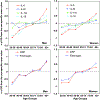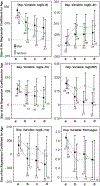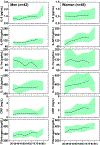The origins of age-related proinflammatory state
- PMID: 15572589
- PMCID: PMC9828256
- DOI: 10.1182/blood-2004-07-2599
The origins of age-related proinflammatory state
Abstract
We hypothesized that the rising levels of inflammatory markers with aging is explained by cardiovascular risk factors and morbidity becoming progressively more prevalent in older persons. Information on inflammatory markers, cardiovascular risk factors, and diseases was collected in 595 men and 748 women sampled from the general population (age, 20-102 years). In both men and women, older age was associated with higher levels of interleukin-6 (IL-6), IL-1 receptor antagonist (IL-1ra), IL-18, C-reactive protein (CRP), and fibrinogen, while soluble IL-6 receptor (sIL-6r) increased significantly with age only in men. Adjusting for cardiovascular risk factors and morbidity, the age regression coefficients became substantially smaller in models predicting IL-6, IL-1ra, IL-18, and fibrinogen and larger in the model predicting sIL6r. Adjustment for cardiovascular morbidity substantially reduced the effect of age on CRP in men but not in women. Findings were confirmed in a subgroup of 51 men and 45 women with low risk profile and no cardiovascular morbidity. Part of the "proinflammatory state" in older persons is related to the high prevalence of cardiovascular risk factor and morbidity.
Figures



References
-
- Bruunsgaard H, Pedersen BK. Age-related inflammatory cytokines and disease. Immunol Allergy Clin North Am. 2003;23:15–39. - PubMed
-
- Roubenoff R, Harris TB, Abad LW, Wilson PW, Dallal GE, Dinarello CA. Monocyte cytokine production in an elderly population: effect of age and inflammation. J Gerontol A Biol Sci Med Sci. 1998;53:M20–M26. - PubMed
-
- Gabay C, Kushner I. Acute-phase proteins and other systemic responses to inflammation. N Engl J Med. 1999;340:448–454. - PubMed
-
- Abbatecola AM, Ferrucci L, Grella R, et al. Diverse effect of inflammatory markers on insulin resistance and insulin-resistance syndrome in the elderly. J Am Geriatr Soc. 2004;52:399–404. - PubMed
-
- Ershler WB. Biological interactions of aging and anemia: a focus on cytokines. J Am Geriatr Soc. 2003;51:S18–S21. - PubMed
Publication types
MeSH terms
Substances
Grants and funding
LinkOut - more resources
Full Text Sources
Other Literature Sources
Medical
Research Materials
Miscellaneous

